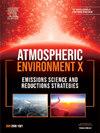Multi-scenario modeling of regional dual-carbon target achievement and air quality improvement: A case study of Zhejiang province
IF 3.8
Q2 ENVIRONMENTAL SCIENCES
引用次数: 0
Abstract
The rise in carbon emissions is a major driver of global warming, and China faces the dual challenge of reducing emissions while addressing air pollution. However, current research lacks comprehensive models that jointly address both carbon reduction and air quality improvement. In this study, we applied the Long-range Energy Alternatives Planning (LEAP) model to project energy consumption and CO2 emissions for baseline, low-carbon, and deep low-carbon scenarios in Zhejiang Province from 2020 to 2060, focusing on six key sectors: residential, agricultural, building, commercial, industrial, and transportation. The Weather Research and Forecasting-Community Multiscale Air Quality (WRF-CMAQ) model was also employed to simulate the spatial and temporal distribution of major air pollutants (NO2, SO2, O3, PM2.5, PM10) in four representative months—April, July, October, and January—under each scenario. The results indicate that (1) the industrial, transport, and residential sectors contribute over 84.7% of energy consumption, CO2 emissions, and air pollutant emissions from 2020 to 2060, identifying them as key targets for mitigation strategies; (2) carbon peaking is not projected under the baseline scenario, but is expected by 2040 in the low-carbon scenario and 2029 in the deep low-carbon scenario, with a peak emission of 208.821 million tons, primarily driven by reductions in the industrial sector; (3) air pollutant emissions across scenarios rank as O3, NO2, PM10, PM2.5, and SO2, indicating the need for stronger O3 control; and (4) the proportion of days meeting national air quality standards remains unchanged, implying further action is necessary to improve air quality. This study provides a theoretical basis and policy support for provincial energy conservation, emissions reduction, and air quality management.
求助全文
约1分钟内获得全文
求助全文
来源期刊

Atmospheric Environment: X
Environmental Science-Environmental Science (all)
CiteScore
8.00
自引率
0.00%
发文量
47
审稿时长
12 weeks
 求助内容:
求助内容: 应助结果提醒方式:
应助结果提醒方式:


